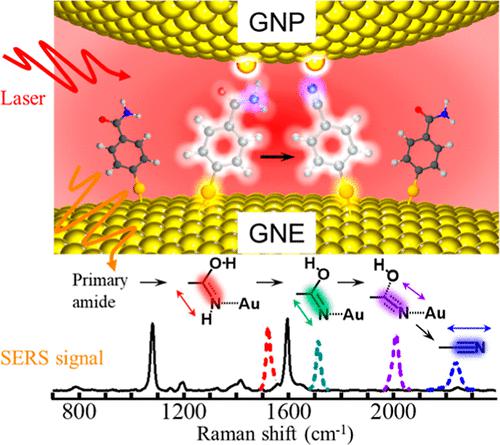当前位置:
X-MOL 学术
›
ACS Catal.
›
论文详情
Our official English website, www.x-mol.net, welcomes your feedback! (Note: you will need to create a separate account there.)
Probing the Intermediates of Catalyzed Dehydration Reactions of Primary Amide to Nitrile in Plasmonic Junctions
ACS Catalysis ( IF 12.9 ) Pub Date : 2022-06-14 , DOI: 10.1021/acscatal.2c01793 Jianghao Zhou 1, 2 , Jing Guo 2 , Alexander Moiseevich Mebel 3 , Govinda Ghimire 2 , Feng Liang 1 , Shuai Chang 1 , Jin He 2, 4
ACS Catalysis ( IF 12.9 ) Pub Date : 2022-06-14 , DOI: 10.1021/acscatal.2c01793 Jianghao Zhou 1, 2 , Jing Guo 2 , Alexander Moiseevich Mebel 3 , Govinda Ghimire 2 , Feng Liang 1 , Shuai Chang 1 , Jin He 2, 4
Affiliation

|
Visible light can effectively drive chemical reactions in plasmonic molecular junctions owing to the high reactivity of adatoms at the surface of plasmonic metal nanostructures and the localized surface plasmon resonance (LSPR)-induced energetic charge carriers (electrons and holes) and heat. Here, we investigated the dehydration reaction of primary amides, which is important to generate valuable nitrile molecules, in the visible-light-irradiated self-assembled gold nanoparticle–aromatic primary amide–gold nanoelectrode junctions in aqueous solution under ambient conditions. At present, the research on the dehydration reaction of the primary amide group is only at the macroscopic level, limiting the mechanistic study of reaction dynamics and intermediates. Using time-resolved surface enhanced Raman spectroscopy (SERS) with tens of millisecond time resolution, we successfully followed the evolution of the SERS spectra along with various transient spectral changes during the rise of the nitrile vibration peak. Combined with density functional theory and a picocavity model, we revealed that most pronounced transient spectral changes were from the gold surface adatom-coupled reaction intermediates. The adatoms produced picocavities with a strong atomic size local field, which strongly enhanced the SERS signals of the intermediates down to sub-single-molecule resolution. The active adatoms played critical roles in producing, interacting, and stabilizing the intermediates. We have determined the complex reaction pathway involving multiple proton transfer steps and intermediates with signature carbon–nitrogen double and triple bonds.
中文翻译:

探索等离子连接中伯酰胺催化脱水反应生成腈的中间体
由于等离子金属纳米结构表面吸附原子的高反应性以及局部表面等离子共振(LSPR)诱导的高能电荷载流子(电子和空穴)和热量,可见光可以有效地驱动等离子分子结中的化学反应。在这里,我们研究了在环境条件下水溶液中可见光照射的自组装金纳米粒子-芳香族伯酰胺-金纳米电极结中伯酰胺的脱水反应,这对于生成有价值的腈分子很重要。目前对伯酰胺基脱水反应的研究还停留在宏观层面,限制了反应动力学和中间体的机理研究。使用具有数十毫秒时间分辨率的时间分辨表面增强拉曼光谱 (SERS),我们成功地跟踪了 SERS 光谱的演变以及腈振动峰上升过程中的各种瞬态光谱变化。结合密度泛函理论和微腔模型,我们发现最明显的瞬态光谱变化来自金表面吸附原子耦合反应中间体。吸附原子产生具有强原子大小局部场的微腔,这将中间体的 SERS 信号强烈增强到亚单分子分辨率。活性吸附原子在产生、相互作用和稳定中间体方面发挥了关键作用。
更新日期:2022-06-14
中文翻译:

探索等离子连接中伯酰胺催化脱水反应生成腈的中间体
由于等离子金属纳米结构表面吸附原子的高反应性以及局部表面等离子共振(LSPR)诱导的高能电荷载流子(电子和空穴)和热量,可见光可以有效地驱动等离子分子结中的化学反应。在这里,我们研究了在环境条件下水溶液中可见光照射的自组装金纳米粒子-芳香族伯酰胺-金纳米电极结中伯酰胺的脱水反应,这对于生成有价值的腈分子很重要。目前对伯酰胺基脱水反应的研究还停留在宏观层面,限制了反应动力学和中间体的机理研究。使用具有数十毫秒时间分辨率的时间分辨表面增强拉曼光谱 (SERS),我们成功地跟踪了 SERS 光谱的演变以及腈振动峰上升过程中的各种瞬态光谱变化。结合密度泛函理论和微腔模型,我们发现最明显的瞬态光谱变化来自金表面吸附原子耦合反应中间体。吸附原子产生具有强原子大小局部场的微腔,这将中间体的 SERS 信号强烈增强到亚单分子分辨率。活性吸附原子在产生、相互作用和稳定中间体方面发挥了关键作用。



























 京公网安备 11010802027423号
京公网安备 11010802027423号